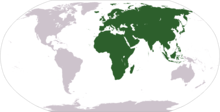Afro-Eurasia
| Area | 84,980,532 km2 (32,811,167 sq mi) |
|---|---|
| Population | 6.7 billion (2019) |
| Population density | 78.5/km2 (204.2/sq mi) |
| Demonym | Afro-Eurasian, Eurafrasian |
| Countries | 147 |
| Dependencies | 17 |
| Time zones | UTC−01:00 – UTC+12:00 |
| Part of | Earth |
Afro-Eurasia (also Afroeurasia and Eurafrasia) is a
Afro-Eurasia encompasses 84,980,532 km2 (32,811,167 sq mi), 57% of the world's land area, and has a population of approximately 6.7 billion people, roughly 86% of the world population. Together with Australia, it comprises the vast majority of land in the world's Eastern Hemisphere. The Afro-Eurasian mainland is the largest and most populous contiguous landmass on Earth.
Related terms
The following terms are used for similar concepts:
- Ecumene: a term from classical antiquity for the world as was known to ancient Greek scholars, which was limited to Europe and parts of Africa and Asia.
- Old World: a term from the Age of Discovery which, for European explorers, contrasted their previously known world from the New World of the Americas.
- World Island: a term coined by H.J. Mackinder in his "The Geographical Pivot of History" (1904) and used in geopolitical contexts.[1] Mackinder defines the World Island as the large contiguous landmass, technically excluding islands such as Great Britain, the Malay Archipelago and the Japanese archipelago.[2] "Afro-Eurasia" generally includes those islands usually considered parts of Africa, Asia, and Europe.
Geology
Although Afro-Eurasia is typically considered to comprise two or three separate continents, it is not a proper supercontinent. Instead, it is the largest present part of the supercontinent cycle.[3]
Past
The oldest part of Afro-Eurasia is probably the Kaapvaal Craton, which together with Madagascar and parts of India and western Australia formed part of the first supercontinent Vaalbara or Ur around 3 billion years ago. It has made up parts of every supercontinent since. At the breakup of Pangaea around 200 million years ago, the North American and Eurasian Plates together formed Laurasia while the African Plate remained in Gondwana, from which the Indian Plate split off. Upon impact with the Eurasian Plate, the Indian Plate created southern Asia around 50 million years ago and began the formation of the Himalayas. Around the same time, the Indian Plate also fused with the Australian Plate.
The
Present
Today, the
Conventionally, Africa is joined to Eurasia only by a relatively narrow land bridge (which has been split by the Suez Canal at the Isthmus of Suez) and remains separated from Europe by the straits of Gibraltar and Sicily.
Future
Extreme points
This is a list of the points that are farther north, south, east or west than any other location as well as the highest and lowest elevations on Afro-Eurasia.
Mainland
- Easternmost Point — Cape Dezhnev†, Russia
- Northernmost Point — Cape Chelyuskin, Russia
- Southernmost Point — Cape Agulhas, South Africa
- Westernmost Point — Pointe des Almadies, Senegal
Including islands
- Easternmost Point — Big Diomede†, Russia
- Northernmost Point —
- Southernmost Point — Cape Agulhas, South Africa. If the Prince Edward Islands are included in Africa, then Marion Island is the southernmost point at 46°54'S.
- Westernmost Point — Santo Antão, Cape Verde
† The 180th meridian passes through Asia, meaning that these points are in the Western Hemisphere.
Elevation
• Highest Point –
• Lowest Point (on land) – Shores of the Dead Sea, between Israel and Jordan
See also
- Extreme points of Earth
- Extreme points of Africa
- Extreme points of Eurasia
- Geography of Africa
- Geography of Asia
- Geography of Europe
- Intermediate Region
- The Geographical Pivot of History
References
- ^ Mackinder, Halford John. The Geographical Pivot of History.
- ^ See Francis P. Sempa, Mackinder's World
- ^ Based upon 2019 population estimates from https://population.un.org/wpp/
- ^ a b Manaugh, Geoff (23 September 2013). "What Did the Continents Look Like Millions of Years Ago?". The Atlantic. Retrieved 22 July 2014.
- ^ "Future World". www.scotese.com.
- ISBN 0-393-01952-7.
Only the inflow of Atlantic water maintains the present Mediterranean level. When that was shut off sometime between 6.5 to 6 MYBP, net evaporative loss set in at the rate of around 3,300 cubic kilometers yearly. At that rate, the 3.7 million cubic kilometres of water in the basin would dry up in scarcely more than a thousand years, leaving an extensive layer of salt some tens of meters thick and raising global sea level about 12 meters.
- ^ Williams, Caroline; Nield, Ted (20 October 2007). "Pangaea, the comeback". New Scientist. Archived from the original on 13 April 2008. Retrieved 28 September 2009.
External links
- Interactive scholarly edition, with critical English translation and multimodal resources mashup (publications, images, videos) Engineering Historical Memory.














